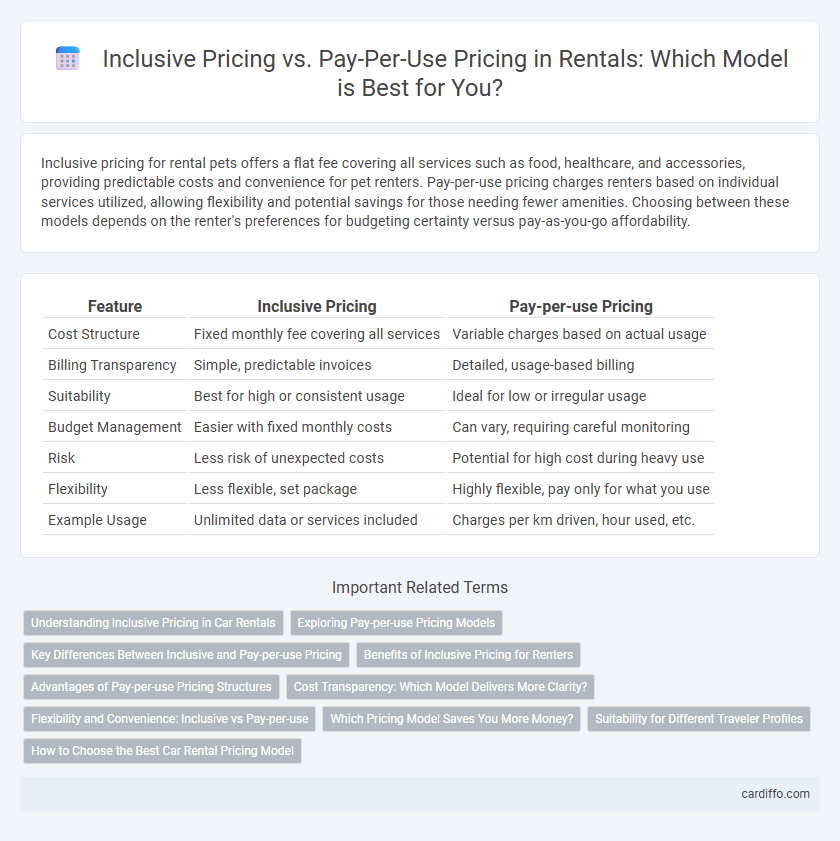Inclusive pricing for rental pets offers a flat fee covering all services such as food, healthcare, and accessories, providing predictable costs and convenience for pet renters. Pay-per-use pricing charges renters based on individual services utilized, allowing flexibility and potential savings for those needing fewer amenities. Choosing between these models depends on the renter's preferences for budgeting certainty versus pay-as-you-go affordability.
Table of Comparison
| Feature | Inclusive Pricing | Pay-per-use Pricing |
|---|---|---|
| Cost Structure | Fixed monthly fee covering all services | Variable charges based on actual usage |
| Billing Transparency | Simple, predictable invoices | Detailed, usage-based billing |
| Suitability | Best for high or consistent usage | Ideal for low or irregular usage |
| Budget Management | Easier with fixed monthly costs | Can vary, requiring careful monitoring |
| Risk | Less risk of unexpected costs | Potential for high cost during heavy use |
| Flexibility | Less flexible, set package | Highly flexible, pay only for what you use |
| Example Usage | Unlimited data or services included | Charges per km driven, hour used, etc. |
Understanding Inclusive Pricing in Car Rentals
Inclusive pricing in car rentals offers a single, all-encompassing fee that covers essential services such as insurance, taxes, and roadside assistance, eliminating unexpected costs during the rental period. This transparent approach simplifies budgeting for customers by providing upfront clarity on total expenses, enhancing convenience and confidence. Compared to pay-per-use pricing, inclusive pricing reduces the risk of variable charges, making it a preferred choice for travelers seeking predictable rental costs.
Exploring Pay-per-use Pricing Models
Pay-per-use pricing models in rental services offer customers flexibility by charging based on actual usage rather than a flat inclusive fee. This approach allows renters to optimize costs for short-term or variable needs, aligning expenses directly with consumption patterns. Tracking usage through digital meters or app-based monitoring enhances transparency and accuracy in billing, making pay-per-use models increasingly popular in equipment, vehicle, and property rentals.
Key Differences Between Inclusive and Pay-per-use Pricing
Inclusive pricing offers a fixed rental fee covering all services and usage, providing cost predictability and convenience for renters. Pay-per-use pricing charges customers based on actual usage, promoting flexibility and potential savings for low consumption but increasing unpredictability in overall costs. The key difference lies in the billing approach: inclusive pricing consolidates expenses into one price, whereas pay-per-use requires tracking and paying for each usage increment separately.
Benefits of Inclusive Pricing for Renters
Inclusive pricing offers renters a predictable monthly cost that covers rent, utilities, and maintenance, eliminating unexpected expenses and simplifying budgeting. This pricing model enhances convenience by consolidating multiple fees into a single payment, reducing administrative tasks and potential stress. Renters benefit from comprehensive service coverage, ensuring prompt repairs and consistent quality without worrying about additional charges.
Advantages of Pay-per-use Pricing Structures
Pay-per-use pricing structures offer renters cost efficiency by charging only for the actual usage, minimizing upfront expenses and eliminating payment for idle resources. This model provides greater flexibility, allowing customers to scale their rental based on fluctuating demand without being locked into fixed fees. Businesses benefit from improved budget control and transparency, as expenses directly correlate with consumption, enhancing financial predictability.
Cost Transparency: Which Model Delivers More Clarity?
Inclusive pricing offers greater cost transparency by bundling all fees into a single payment, eliminating unexpected charges and simplifying budget management for renters. Pay-per-use pricing can obscure total costs due to variable fees based on usage, making it harder for renters to predict monthly expenses accurately. Clear, upfront pricing in inclusive models reduces financial uncertainty and enhances trust between renters and service providers.
Flexibility and Convenience: Inclusive vs Pay-per-use
Inclusive pricing offers renters a predictable, all-in monthly fee covering utilities, maintenance, and amenities, enhancing financial convenience and ease of budgeting. Pay-per-use pricing provides greater flexibility by allowing customers to pay solely for the services or resources they utilize, ideal for those with fluctuating or minimal usage needs. This model supports cost optimization but may require more diligent tracking to avoid unexpected expenses, balancing convenience with tailored flexibility.
Which Pricing Model Saves You More Money?
Inclusive pricing offers a fixed rental cost covering all fees, providing predictability and eliminating unexpected expenses, which is ideal for long-term or frequent renters. Pay-per-use pricing charges based on actual usage, often saving money for short-term or occasional users by avoiding high upfront costs. Assessing rental frequency and usage patterns helps determine which pricing model delivers the best financial savings.
Suitability for Different Traveler Profiles
Inclusive pricing offers travelers a fixed rate that covers accommodation, utilities, and often amenities, making it ideal for budget-conscious travelers or those seeking simplicity and predictability. Pay-per-use pricing appeals to travelers with variable usage patterns, such as digital nomads or short-term visitors, who prefer paying only for services they actually consume. Family travelers and long-term renters often benefit from inclusive pricing due to cost stability, while adventure travelers favor pay-per-use options for flexibility and cost efficiency.
How to Choose the Best Car Rental Pricing Model
Choosing the best car rental pricing model depends on your usage frequency and budget predictability. Inclusive pricing offers a fixed rate covering insurance, taxes, and mileage, providing cost certainty for longer rentals or frequent use. Pay-per-use pricing charges based on actual mileage and usage, ideal for occasional renters seeking lower upfront costs.
Inclusive Pricing vs Pay-per-use Pricing Infographic

 cardiffo.com
cardiffo.com